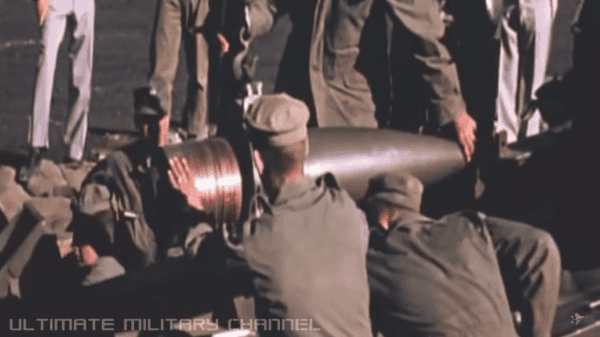The United States Department of Defense has developed some incredibly powerful weapons. During the 1950s, it became evident after the Korean War (or after WWII really) that Russia wouldn’t be an ally but a formidable foe. With the strategic advantage of possessing nuclear technology that nobody else had right at that time, the most powerful gun was created: the M65 Atomic Cannon.

Loading the warhead (YouTube)
Nicknamed “Atomic Annie,” the M65 Atomic Cannon was a towed artillery piece developed in the early 1950s, at the beginning of the Cold War, and fielded by 1953 in Europe and Korea. Capable of firing a 15 kiloton nuclear warhead – about the same size as the bomb dropped on Hiroshima – a distance of 7 miles. It was fired only once, and it stands today as the most powerful gun ever fired.
On May 25, 1953, a test shot was fired at the Nevada Proving Grounds at Frenchman’s Flat, Nevada. The Atomic Cannon test was history’s first atomic artillery shell fired from the Army’s 280-mm artillery gun. This operation consisted of eleven atmospheric detonations, and took place at the Nevada Test Site between March 17 and June 4, 1953.
Watch the video to get a grim reminder of the horrific potentials of war and its weapons.
There were three airdrops, seven tower shots, and one warhead fired from an atomic cannon. The M65 test-firing was dubbed Grable, and was the next-to-the-last of the eleven tests. About 20,000 military personnel participated in Upshot-Knothole as part of the Desert Rock V exercise. The W9 warhead traveled just under seven miles before detonating.
While plenty of nuclear weapons came and went over the course of the Cold War, the Atomic Annie is still remembered as the deadliest. The fact is that this giant gun could fire a nuclear weapon with a range of 20 miles and detonate an entire enemy at once. Even though it was only fired once, it can still be seen at Fort Sill army base in Lawton, Oklahoma. There’s a commemorative rock next to it with an attached plaque that details the history of the gun.

Firing the cannon (YouTube)
After the successful test of the gun, twenty atomic cannons were produced, and each cost over $800,000. The cannons were sent to several parts of the world, including Europe and Korea, but none of them were put to action. Out of those, only eight have survived, including Atomic Annie.
The M65 was effectively obsolete soon after it was deployed due to the development of nuclear shells compatible with existing artillery pieces. The weapon was retired in 1963.



